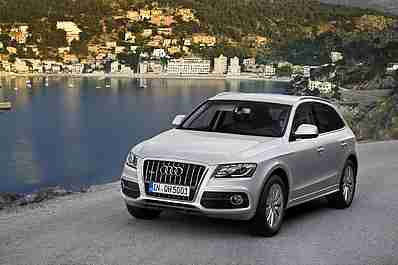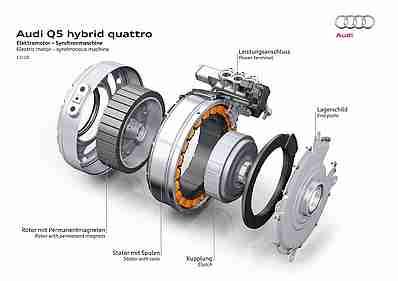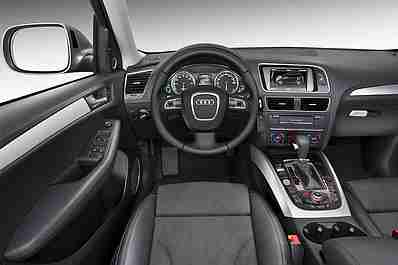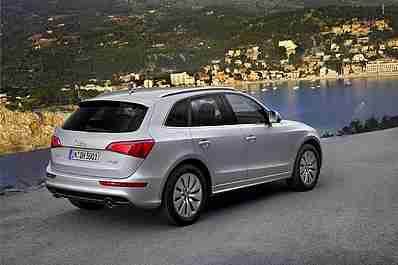 Delivering 180 kW (245 hp) of system performance and 480 Nm
(354.03 lb-ft) of torque, its 2.0 TFSI gasoline engine and electric motor
ensure sporty dynamics while achieving an average fuel consumption in the
normal cycle (NEDC) of under 6.9 liters per 100 km (33.60 US mpg). During
the development process, Audi focused on a high share of electrically powered
driving. The sportiest hybrid SUV on the market can drive up to 100 km/h
(62.14 mph) under electric power alone and covers about three kilometers
locally emission-free at a speed of 60 km/h (37.28 mph). With the powerful,
lightweight lithium-ion battery and many other solutions, the Audi Q5 hybrid
quattro represents the state of the art. Delivering 180 kW (245 hp) of system performance and 480 Nm
(354.03 lb-ft) of torque, its 2.0 TFSI gasoline engine and electric motor
ensure sporty dynamics while achieving an average fuel consumption in the
normal cycle (NEDC) of under 6.9 liters per 100 km (33.60 US mpg). During
the development process, Audi focused on a high share of electrically powered
driving. The sportiest hybrid SUV on the market can drive up to 100 km/h
(62.14 mph) under electric power alone and covers about three kilometers
locally emission-free at a speed of 60 km/h (37.28 mph). With the powerful,
lightweight lithium-ion battery and many other solutions, the Audi Q5 hybrid
quattro represents the state of the art.
Performance
The 2.0 TFSI and the electric motor of the Audi Q5 hybrid are mounted directly
behind one another as a parallel hybrid system – a straight-line concept
with impressive efficiency. Together they have a system output of 180 kW
(245 hp) and a system torque of 480 Nm (354.03 lb-ft). The Audi Q5 hybrid
sprints from 0 to 100 km/h (62.14 mph) in 7.1 seconds, while the interim
sprint from 80 to 120 km/h (49.71 to 74.56 mph) is accomplished in fifth
gear in 5.9 seconds. The propulsion ends at no less than 222 km/h (137.94
mph). In the normal cycle, the Audi Q5 hybrid quattro consumes 6.9 liters
of fuel per 100 km (33.60 US mpg) – that corresponds to a CO2 emissions
level of 159 g per km (257.50 g/mile). The 75-liter (19.81-US gallon) tank
yields an impressive range comparable to that of a TDI.
Drivetrain
 The 2.0 TFSI in the Audi Q5 hybrid quattro has a displacement
of 1984 cc. Its output is 155 kW (211 hp), with the maximum torque of 350
Nm (258.15 lb-ft) permanently available between 1,500 and 4,200 rpm. The
four-cylinder unit combines gasoline direct injection with turbocharging.
The Audi valve lift system (AVS) further increases power, torque and efficiency
by switching the stroke of the exhaust valves between two stages depending
on the load and rpm. The 2.0 TFSI has been overhauled in some respects for
use in the Audi Q5 hybrid. The drive of the ancillary units has been dropped,
and the crankshaft bearing and fine tuning of the turbocharger have been
adapted to the specific demands. A secondary air system at the cylinder head
makes sure that the exhaust gas treatment cuts in particularly fast. Integrated
in the engine control unit, the so-called hybrid manager controls the efficient
change and smooth transitions between the operating modes. A largely modified
eight-speed tiptronic serves as the power transmission without the aid of
a torque converter. Its place is taken by the disk-shaped electric motor,
combined with a multi-plate clutch bathed in oil, which couples and decouples
the electric motor and the TFSI. The innovative decoupler operates precisely
and smoothly in any situation. The highly comfortable and fast-shifting hybrid
gear unit contributes significantly to the efficiency of the Audi Q5 hybrid
– its eight gears are widely spaced. When the 2.0 TFSI is deactivated,
an electric pump maintains the oil pressure in the hydraulic system to safeguard
the convenient start-stop feature. The 2.0 TFSI in the Audi Q5 hybrid quattro has a displacement
of 1984 cc. Its output is 155 kW (211 hp), with the maximum torque of 350
Nm (258.15 lb-ft) permanently available between 1,500 and 4,200 rpm. The
four-cylinder unit combines gasoline direct injection with turbocharging.
The Audi valve lift system (AVS) further increases power, torque and efficiency
by switching the stroke of the exhaust valves between two stages depending
on the load and rpm. The 2.0 TFSI has been overhauled in some respects for
use in the Audi Q5 hybrid. The drive of the ancillary units has been dropped,
and the crankshaft bearing and fine tuning of the turbocharger have been
adapted to the specific demands. A secondary air system at the cylinder head
makes sure that the exhaust gas treatment cuts in particularly fast. Integrated
in the engine control unit, the so-called hybrid manager controls the efficient
change and smooth transitions between the operating modes. A largely modified
eight-speed tiptronic serves as the power transmission without the aid of
a torque converter. Its place is taken by the disk-shaped electric motor,
combined with a multi-plate clutch bathed in oil, which couples and decouples
the electric motor and the TFSI. The innovative decoupler operates precisely
and smoothly in any situation. The highly comfortable and fast-shifting hybrid
gear unit contributes significantly to the efficiency of the Audi Q5 hybrid
– its eight gears are widely spaced. When the 2.0 TFSI is deactivated,
an electric pump maintains the oil pressure in the hydraulic system to safeguard
the convenient start-stop feature.
Power electronics and electric motor
 The radiator tank in the engine bay houses the power electronics.
The so-called pulse-controlled inverter serves as a controller between the
battery, which outputs direct current, and the electric motor that operates
on alternating current. Innovative technologies keep the volume and weight
of the power electronics low, with cooling provided by a separate low-temperature
water-filled circuit. The component includes a DC/DC converter that couples
the electric consumers in the 12 V electrical system with the high-voltage
network. A permanently excited synchronous machine serves as an electric
motor, as a starter and – during deceleration – as an alternator.
It delivers up to 40 kW (54 hp) of power and 210 Nm (155.63 lb-ft) of torque.
The electric motor is integrated in the engine’s cooling circuit. The radiator tank in the engine bay houses the power electronics.
The so-called pulse-controlled inverter serves as a controller between the
battery, which outputs direct current, and the electric motor that operates
on alternating current. Innovative technologies keep the volume and weight
of the power electronics low, with cooling provided by a separate low-temperature
water-filled circuit. The component includes a DC/DC converter that couples
the electric consumers in the 12 V electrical system with the high-voltage
network. A permanently excited synchronous machine serves as an electric
motor, as a starter and – during deceleration – as an alternator.
It delivers up to 40 kW (54 hp) of power and 210 Nm (155.63 lb-ft) of torque.
The electric motor is integrated in the engine’s cooling circuit.
Battery
A lithium-ion battery system, weighing merely 38 kg (83.78 lb), serves as
the energy store for the electric motor of the Audi Q5 hybrid quattro. The
compact unit with its 26-liter (6.87 US-gallon) capacity is positioned in
a crash-safe area under the loading floor, with hardly any detriment to the
luggage compartment. The battery consists of 72 cells; at 266 volts its nominal
energy is 1.3 kWh and its output 39 kW. The lithium-ion battery is cooled
by air in two ways, depending on the requirement. At low-temperature load,
it draws temperate air from the vehicle interior by way of a fan. If its
temperature exceeds a certain limit, a separate refrigerant circuit is activated.
It is coupled to the main climate control system of the vehicle and uses
a separate evaporator. This efficient, active cooling mechanism is a major
factor in the hybrid system's high electric availability and sets the Audi
Q5 hybrid quattro apart from many other hybrid vehicles.
Operating modes
The Audi Q5 hybrid quattro can be driven in five operating modes. Driving
with the combustion engine alone, with the electric drive alone or in hybrid
mode is possible, as are recuperation and boosting. At a standstill –
before starting or at a traffic light, for instance – both drive sources
are deactivated. In this “comfort” start-stop mode, the climate
control system remains active. Once the driver releases the brake, the Q5
hybrid quattro begins coasting. It can be driven up to 100 km/h (62.14 mph)
under electric power – with almost no noise or local emissions. At a
constant speed of 60 km/h (37.28 mph), it has a range of 3 km – enough
for many residential areas and city centers. The driver can change between
three programs using a button on the center console or the selector lever.
The EV characteristic map gives priority to the electric drive in the city,
the D mode controls both motors for optimal consumption, and the S mode as
well as the touch control gate of the tiptronic are designed for a sporty
driving style. If the driver accelerates quickly, the combustion engine takes
over and delivers traction. Now the electric motor’s main job is to
power the on-board consumers and keep the accumulator battery charged. In
quick acceleration, or “boosting,” the electric motor operates
together with the TFSI; at full throttle in the S mode the full system output
is briefly available. In such cases, the hybrid drive supplies the propulsion
power of a large naturally aspirated engine, but with far more efficiency.
When the driver releases the accelerator, the electric motor acts as an
alternator and recovers energy. In most situations the TFSI is then decoupled
from the drive system so as not to cause any drag losses. The electricity
recovered by the electric motor here and in braking is buffered in the
lithium-ion battery. If the driver brakes only slightly, the electric motor
performs the deceleration by itself; in more forceful braking the hydraulic
braking system is simultaneously activated.
Vehicle operation
 The Audi Q5 hybrid features a novel display concept, in which
each of the hybrid drive’s driving modes can be experienced. The tachometer
has been replaced on the instrument cluster by a “power meter,”
with a needle that indicates the total system output on a scale of 0 to 100.
A second scale is divided into colored segments; its green and orange segments
clearly show which drive system the Q5 hybrid quattro is currently using.
An additional instrument displays the charge level of the battery. At the
same time, the display of the driver information system and the large monitor
of the MMI Navigation plus show the operating states and power flows in the
hybrid system in elegant graphics with a three-dimensional effect. The MMI
screen also displays differentiated consumption and recuperation statistics
in easily understandable bar graphs. The latest-generation MMI navigation
plus is standard in the Audi Q5 hybrid quattro. The storage capacity of the
hard drive is 60 GB, the menus can be selected via a state-of-the-art wizard,
and the album tracks are displayed using the cover artwork. An external device
such as a cell phone or player can be connected via Bluetooth, and the voice
input understands town and street names in a single command. The resonant
Audi sound system is also standard. The Audi Q5 hybrid features a novel display concept, in which
each of the hybrid drive’s driving modes can be experienced. The tachometer
has been replaced on the instrument cluster by a “power meter,”
with a needle that indicates the total system output on a scale of 0 to 100.
A second scale is divided into colored segments; its green and orange segments
clearly show which drive system the Q5 hybrid quattro is currently using.
An additional instrument displays the charge level of the battery. At the
same time, the display of the driver information system and the large monitor
of the MMI Navigation plus show the operating states and power flows in the
hybrid system in elegant graphics with a three-dimensional effect. The MMI
screen also displays differentiated consumption and recuperation statistics
in easily understandable bar graphs. The latest-generation MMI navigation
plus is standard in the Audi Q5 hybrid quattro. The storage capacity of the
hard drive is 60 GB, the menus can be selected via a state-of-the-art wizard,
and the album tracks are displayed using the cover artwork. An external device
such as a cell phone or player can be connected via Bluetooth, and the voice
input understands town and street names in a single command. The resonant
Audi sound system is also standard.
quattro drive and chassis
quattro permanent four-wheel drive reliably applies the power of both power
units to the road in any situation. In the normal condition the sporty drive
is emphasized at the rear; if need be, it transmits most of the power to
the axle with the better traction. The sophisticated chassis includes many
aluminum components for reduced weight. The Audi Q5 hybrid quattro is capable
of pulling trailer loads of up to 2000 kg (4,409 lb). The steering is based
on an electromechanical system. The system is extremely efficient because
it consumes no energy when driving straight ahead. The brake servo is
additionally supplied by an electric vacuum pump. A complex control strategy
adapts the braking to the conditions of electric driving and energy recuperation.
Exterior
Subtle visual effects on the exterior are a signature feature of the Audi
Q5 hybrid quattro. The rear hatch, fenders and aluminum door sills bear hybrid
badges. The radiator grill is painted a high-gloss black, and the tailpipes
are trimmed in chrome. An exclusive paint finish in Arctic Silver metallic
is available as an option. The 19-inch cast aluminum wheels were specially
designed for the hybrid – their ten spokes are reminiscent of turbine
blades. The tires are size 235/55. Audi also offers customers 19- and 20-inch
diagonal wheels, and an S line bumper is available from quattro GmbH. The
body is extraordinarily light, with the rear hatch and engine hood made of
aluminum. The rigid body shell incorporates hot-shaped steel in numerous
places, combining low weight with extremely high strength. Despite an extensive
array of standard equipment, the Q5 hybrid quattro with its curb weight of
less than 2000 kg (4,409 lb) is the lightest hybrid SUV on the world market.
All of its hybrid components add less than 130 kg (286.60 lb) of extra weight.
Equipment and trim
 The climate control system in the Audi Q5 hybrid is adapted
to the requirements of electric driving. A high-voltage electric drive was
used for the compressor. It operates on-demand, making it highly efficient.
An electric auxiliary heater ensures that the cabin heats up quickly. The
Audi Q5 hybrid quattro offers virtually the same equipment as its successful
sibling models – the model series leads the European market in the mid-sized
SUV segment. The options also include the advanced Audi driver assistance
systems. A new feature is Internet connectivity via the optional Bluetooth
car phone online. A UMTS model connects to special services from Google and
the World Wide Web, allowing the car to retrieve the latest news and weather
information. Through the fast connection the hybrid SUV also downloads
three-dimensional satellite images and aerial photos from Google Earth. These
appear in a bird’s eye view on the monitor, and the computer fills in
the roads. Another high-end feature is the WLAN hotspot, which allows passenger
to connect up to eight terminal devices to the Internet. The climate control system in the Audi Q5 hybrid is adapted
to the requirements of electric driving. A high-voltage electric drive was
used for the compressor. It operates on-demand, making it highly efficient.
An electric auxiliary heater ensures that the cabin heats up quickly. The
Audi Q5 hybrid quattro offers virtually the same equipment as its successful
sibling models – the model series leads the European market in the mid-sized
SUV segment. The options also include the advanced Audi driver assistance
systems. A new feature is Internet connectivity via the optional Bluetooth
car phone online. A UMTS model connects to special services from Google and
the World Wide Web, allowing the car to retrieve the latest news and weather
information. Through the fast connection the hybrid SUV also downloads
three-dimensional satellite images and aerial photos from Google Earth. These
appear in a bird’s eye view on the monitor, and the computer fills in
the roads. Another high-end feature is the WLAN hotspot, which allows passenger
to connect up to eight terminal devices to the Internet. |

